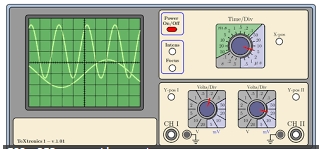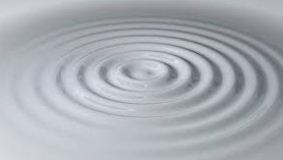Ed's
AV Handbook
Batting Practice for the AV Professional
and primer for the novice
Chapter 2 Page 2
AV Physics
The Acoustical Energy
of Sound
Sound
is the compression and rarefaction of sound waves
traveling through air. Sources of sound compress
(squeeze) air molecules, which then rarefact
(expand). The rarefaction compresses adjoining
molecules, which rarefact-compress adjacent
molecules. The cycle continues until it terminates
in the ear or fades into the atmosphere. It is the
cycle of sound.
Handbook Note:
Hertz (Hz) = cycles per second.
One thousand = one Kilo or K
Hertz (Hz) = cycles per second.
One thousand = one Kilo or K
Mega,
meg, or M = one million
KHz = one thousand Hertz
KHz = one thousand Hertz
MHz
= one million Hertz
Lines on an
O-scope

Audio
engineers translate sound into measurable illuminated
lines on the screen of an oscilloscope. The
o-scope modulating lines illustrate the wavelength,
amplitude, and frequency of a sound wave.
The
oscilloscope reveals a ten-octave frequency range of
sound that spans from 20Hz to 20KHz. The area of
20Hz to about 500Hz covers bass and rhythm
frequencies. The core of the human voice and
instruments occupies the region of approximately 500Hz
to 2KHz. The balance generates vocal detail
and ringing-reverberating sound.
Handbook Note:
The speed of sound = 1130 ft/second
The speed of sound = 1130 ft/second
You
may compute the wavelength of sound by dividing
the speed of sound by the frequency. For example,
20Hz has a wavelength of 56.5 feet or 1130 ÷ 20, while
20KHz has a wavelength of about 0.0565 of an inch or
1130 ÷ 20K.
The
amplitude or objective volume
measurement of sound is the decibel (db), a logarithmic
unit of sound pressure. It is a scale that extends
from 0db to 194db. Sound
engineers employ a logarithmic scale because of the
immense range of human ear. It spans from the
threshold of hearing to beyond the level of pain.
The threshold of hearing is the level created by a
molecule of air landing on the surface of the
eardrum. You read that right. The pain
threshold is at about the sound pressure level of a
large aircraft during takeoff at close range -- 120db.
Subjective Response
In
the 1930s, Bell Labs researchers Fletcher and Munson
observed that the subjective response of the
human ear differed from the objective measurement of
sound pressure level. They determined that the
human ear is most sensitive to the range of 1KHz to
5KHz.
Frequencies above and below must be increased in volume
to perceive as equal volume. The effect becomes
more prominent as the volume decreases. The effect
diminishes as volume increases. Fletcher and
Munson defined this subjective or psycho-acoustical
response to sound as loudness.

Handbook Notes:
-
A doubling of loudness =
about 9 to 10 db change in sound pressure level.
- A doubling of amplified power =
an increase of about 3db.
about 9 to 10 db change in sound pressure level.
- A doubling of amplified power =
an increase of about 3db.
-
Speed of sound =
1130ft/second at seal level.
-
Frequency range of audible sound =
about 20Hz to 20KHz.
-
Range of audible wavelengths =
about 56.5 ft. to 0.0565 in.
about 56.5 ft. to 0.0565 in.
-
Threshold of hearing = 0db
-
Threshold of pain = 120db
Ed's AV
Handbook
Copyright 2007 Txu1-598-288 Revised 2025
Copyright 2007 Txu1-598-288 Revised 2025
Architectural
Speaker Tuning System
for
in-wall/ceiling custom installed speakers.
Reclaim the performance you paid for
Site Menu
Home
Table of
Contents
Handbook Chapters
1 AV
Terms
2 AV Physics
3 Sound Reproduction
4 Video Reproduction
5 The AV System Sequence
6 The Room, Speaker, & TV
7 Acoustical Strategy - Small Room
8 Home Theater by Design
9 AV Sales Training
10 AV Business & Marketing
Contact
About

